Gardening For A Garden Railroad
This page is about gardening for a garden railroad in your yard.
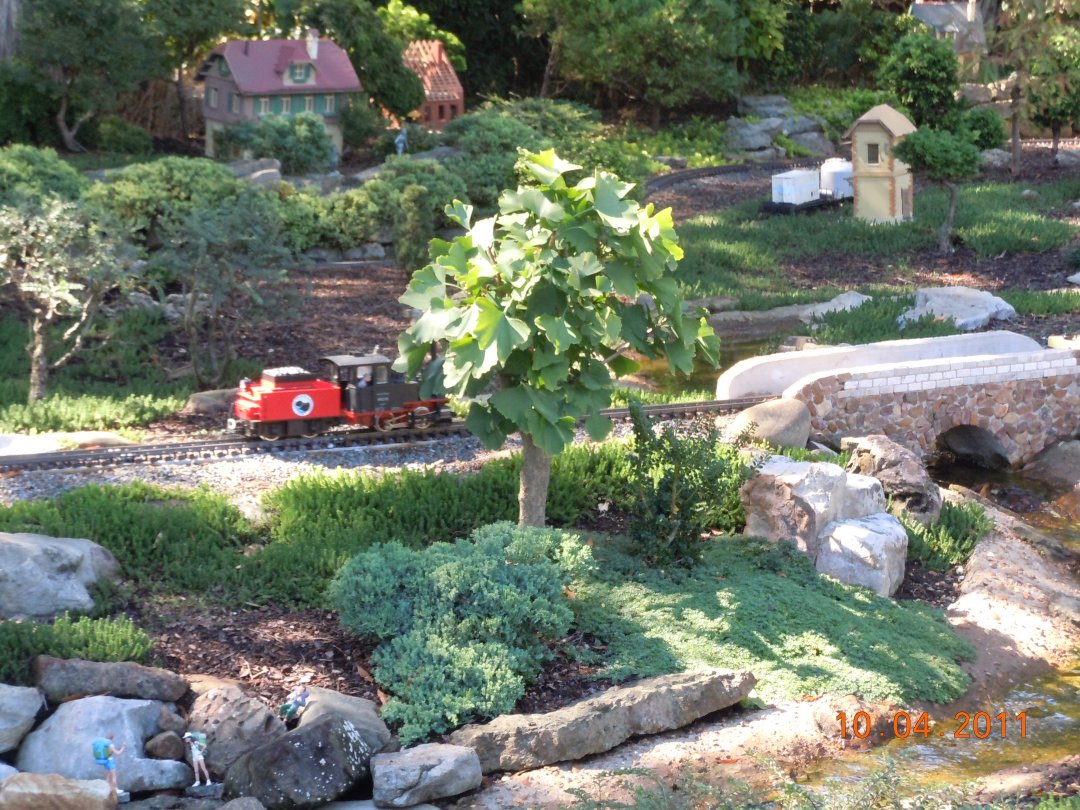 We were actually led into garden railroading from gardening, not vice-versa. My wife and I are both retired and had both taken our state's extension service course to become "Master Gardeners". Our interest in gardening took us to the Huntsville Botanical Gardens where we saw our first G-Gauge garden train in person. We both had the simultaneous thought that we ought to do that. When we got back home, we jumped into planning it.
We were actually led into garden railroading from gardening, not vice-versa. My wife and I are both retired and had both taken our state's extension service course to become "Master Gardeners". Our interest in gardening took us to the Huntsville Botanical Gardens where we saw our first G-Gauge garden train in person. We both had the simultaneous thought that we ought to do that. When we got back home, we jumped into planning it.
The train in the Huntsville garden train layout was not so much the impressive part as was the garden. They had hundreds of bonsai plants of many different kinds scattered among G scale houses, tunnel, bridges, and figures. We knew very little about "bonsai" at the time (still don't know much). We have found, however, that to be bonsai it doesn't have to be that single type of dwarf evergreen that we have seen asian monks clipping on TV. Notice from the picture of Huntsville garden that in the center of the picture is what appears to be a miniature sycamore tree. If they can grow a sycamore that small, surely we could grow some dwarf plants too.
We are in the experimental stage of miniature gardening since we only got the call this Fall and, therefore, haven't planted very many small plants, nor have we had the active growing season to see how the plants will do. We have divided our efforts into two areas: water gardening, and bonsai gardening. Of course we want the water plants to be small too so they will fit in with the scale as much as possible but water gardening is a different animal than growing dry land plants. Since we finished the waterfall, stream and pond first, we tried the water plants first.
Water Plants
We had no idea where to even begin on water plants. So, we first went to our local Lowe's to see what they had -- they had no, zero, zip water plants. The clerk there said they used to handle them but they sold very few so they dropped them. Well, we figured that our Home Depot might have been more successful in that area so we tried them, but, alas, no. They had none either. We began to think we were trying at the wrong time of year (October) which probably was true but we should have been able to find something.
Our next idea was to go to a pet store where they had an aquarium with water plants in it. We did achieve some success there. We bought a couple of small plants that were sold in a plastic tube. Some sort of water lilies that were not specifically identified. But, even more helpful when viewing their aquarium, we noticed they had some plain old dwarf liriope growing underwater. We had plenty of that. Seeing the dwarf liriope also gave us courage to try some other plants in the water.
We rushed on home and put in our generic water lilies but also scrapped up some dwarf liriope from a patch or two we had planted around the house.
We put a bit of liriope in the water in a pot as well as a bunch next to the stream to serve as, maybe, some G Scale Pampas grass or something (see photo). We had previous experience with liriope, also called "monkey grass" and knew that it was slow growing but would spread over time. We used the fine blade grass that appeared to fit better to scale.
We also happened to have a couple of airplane plants lying around the house from a previous adventure (long story) so we decided to plunk one of those in the pond in a pot too. We have been pleasantly surprised at how well the airplane plant is doing. It actually seems to be thriving. Note that the photo is of one of the "airplanes" coming off the main root that is in a pot sitting in and inundated by water. Airplane plant is normally a house plant though and even though it's doing well right now, we don't know how well it will tolerate our winter (temps down to teens sometimes) when the pond gets a skim of ice on it. We are fairly confident that it will do well in the summer time because the water will tend to moderate the hot days. It's an experiment in progress.
We have been pleasantly surprised at how well the airplane plant is doing. It actually seems to be thriving. Note that the photo is of one of the "airplanes" coming off the main root that is in a pot sitting in and inundated by water. Airplane plant is normally a house plant though and even though it's doing well right now, we don't know how well it will tolerate our winter (temps down to teens sometimes) when the pond gets a skim of ice on it. We are fairly confident that it will do well in the summer time because the water will tend to moderate the hot days. It's an experiment in progress.
 In the pot with the liriope is one of the generic water lilies that we bought in plastic tubes. They are not impressive but we think the liriope will be in a few years.
In the pot with the liriope is one of the generic water lilies that we bought in plastic tubes. They are not impressive but we think the liriope will be in a few years.
We are going to let the water gardening stand at that point until spring when we won't be risking so much with the immediate winter facing the water plants. We'll start a few more water plant trials then.
Bonsai or Miniature Plants
Now to the land plants. Our first plants to try to miniaturize were junipers. They come in various forms and growth habits:
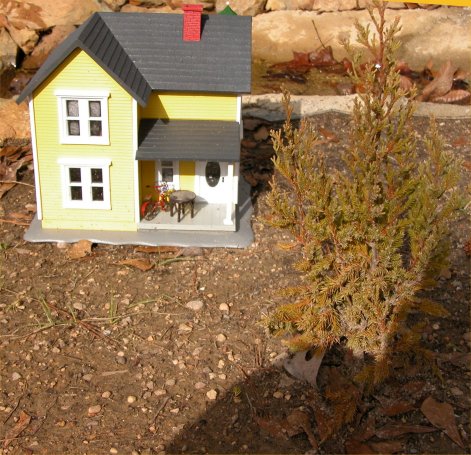

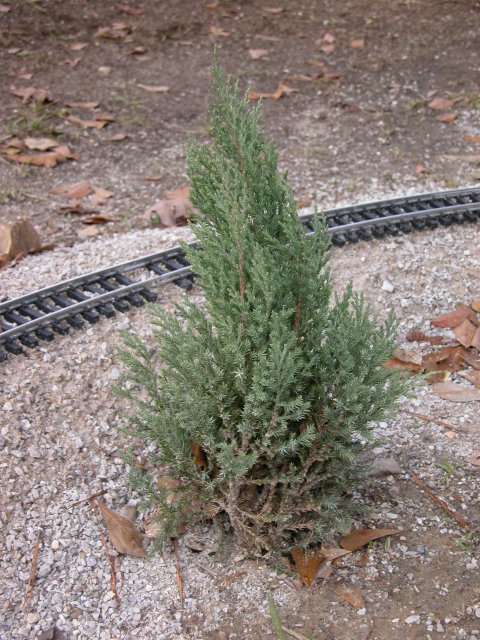

According to our research the art of bonsai requires frequent potting, trimming, unpotting, trimming roots, repotting, trimming tops over and over again. We like to plant something and leave it alone for a while. I considered that leaving a plant in a pot tends to restrict the roots from spreading and would, therefore, tend to keep it small. So, all but the blue rug juniper pictured above are still in pots set even with the surface of the ground. We want the blue rug to spread but not the others. Again, this is an experiment in progress.
Other than the junipers, we have a few other plants in place. We have a couple of types of sedum both of which are doing fine so far (after only about two months):
One of the sedum types is pictured here. There are about as many different types of sedum as Carter has liver pills so your choices are almost unlimited. Most types of sedum do well in our USDA zone in central Alabama (7b). They are cold hardy and slow growing so they will require minimum maintenance (that's what I'm after). We'll be trying more types soon.
 We are also trying a few plants not normally thought of as miniature or bonsai. Pachysandra for ground cover is slow growing (at least for us it is) and grows well in partial shade. We planted a few sprigs of it around rocks hoping for it to grow and spill out onto the rocks over time.
We are also trying a few plants not normally thought of as miniature or bonsai. Pachysandra for ground cover is slow growing (at least for us it is) and grows well in partial shade. We planted a few sprigs of it around rocks hoping for it to grow and spill out onto the rocks over time.
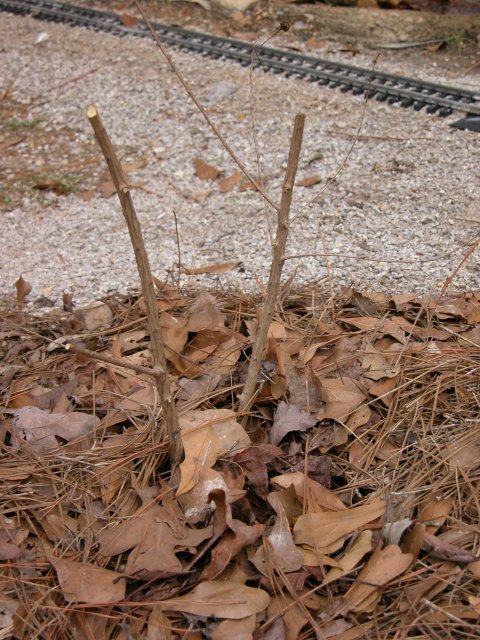 The only plants we already had growing in the area we chose for Mulberrytown were dwarf crepe myrtles. They had been in place for about a year and were growing larger than would be appropriate for G Scale so we trimmed them back. Or rather, I trimmed them back. My wife didn't think much of the idea of trimming them back in the late Fall. I went for the rule of thumb of trimming after blooming and crepes bloom in the Summer/Fall. I hope to keep them trimmed down to reasonably small size since they are a prominent feature at the edge of Mulberrytown.
The only plants we already had growing in the area we chose for Mulberrytown were dwarf crepe myrtles. They had been in place for about a year and were growing larger than would be appropriate for G Scale so we trimmed them back. Or rather, I trimmed them back. My wife didn't think much of the idea of trimming them back in the late Fall. I went for the rule of thumb of trimming after blooming and crepes bloom in the Summer/Fall. I hope to keep them trimmed down to reasonably small size since they are a prominent feature at the edge of Mulberrytown.
That's it for our beginning on a miniature garden. This page will be updated as our plants proliferate (or not).
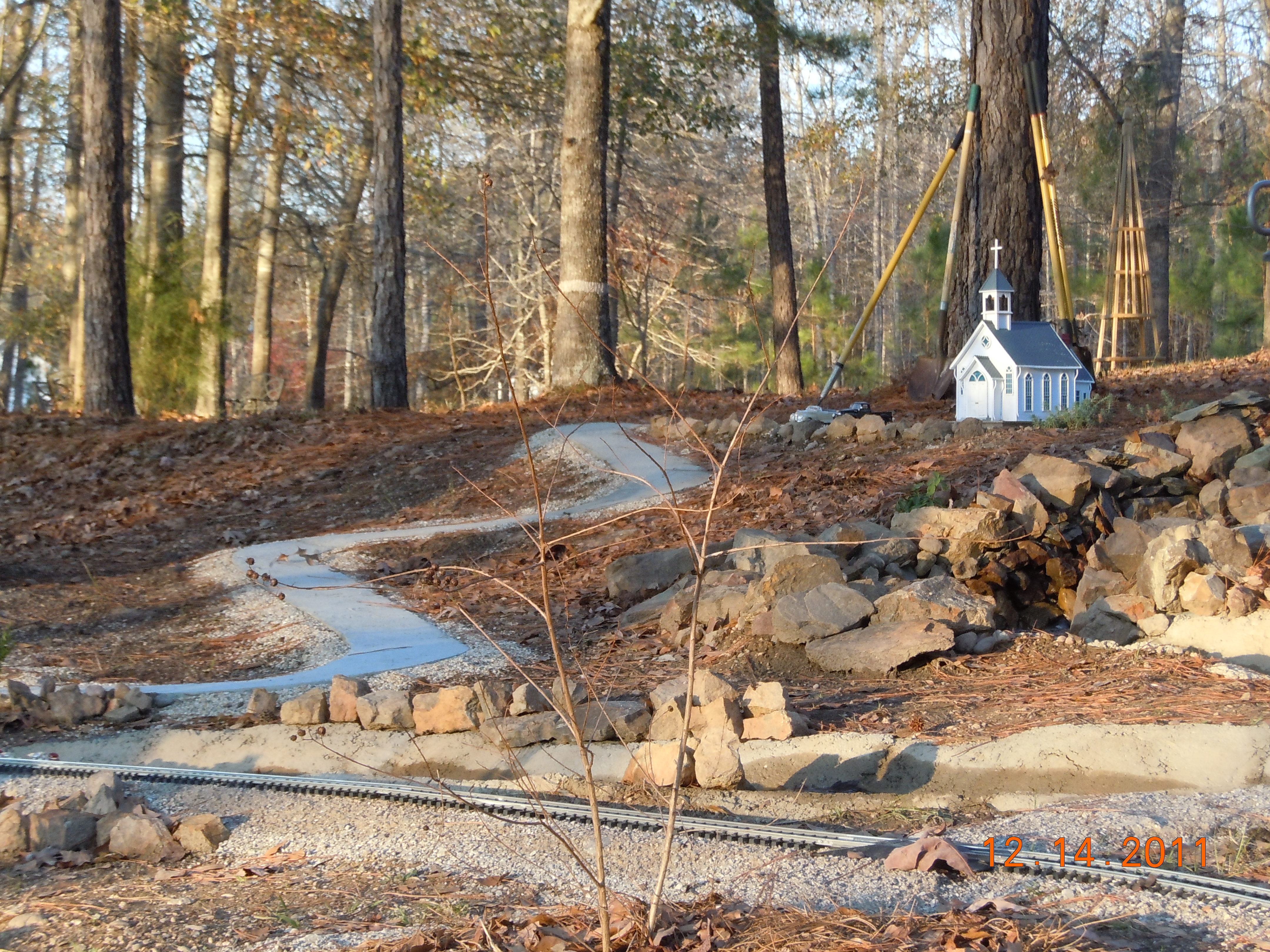

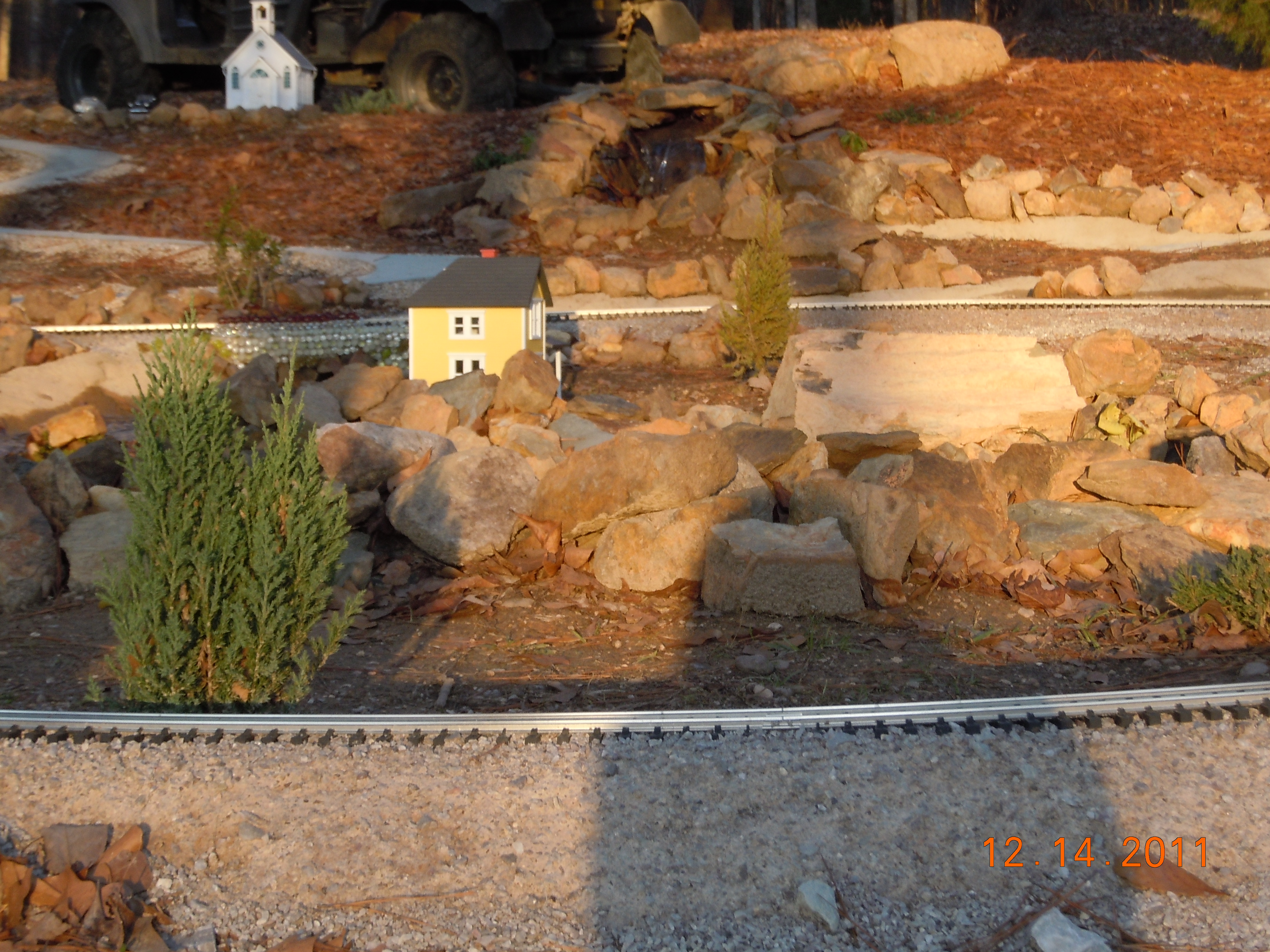
The three pics above are several months after initial construction. Notice in the first and last pics we have a plastic church and a yellow plastic house. These did NOT hold up well outside -- dirt splashed onto them keeping them nasty and the plastic tended to discolor and warp from sun, etc. So if you look closely at the center pic, we found a nice lady who made G-scale buildings out of concrete. These worked much better! Unfortunately our nice lady that made these houses moved away and stopped doing them. : (

